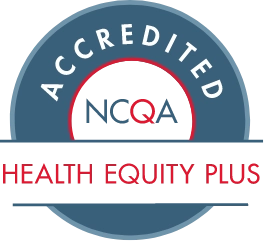Being Better Clinical Partners
By collaborating with our care provider partners, and sharing expertise and resources, we can make impactful strides together toward our common goal to advance whole health. To do that, we developed strategies and programs designed to make us better clinical partners.
Concierge Care
Managing a serious health condition can be challenging not only for patients and their families but also for care providers.
To help make that easier, our health plan affiliates are focused on developing complementary clinical programs, like Concierge Care.
Concierge Care is a digitally enabled care management program based in a consumer-facing app that provides education, health trackers, tools, and on-demand chat between our consumers with identified health conditions and our care teams. Health Advocates, who are specially trained nurses, health coaches, health educators, or care managers, engage with participants one-on-one via their preferred communication channel — text, email, chat, or phone — becoming trusted members of the care team.
Changing Lives for the Better
Hear one consumer's story about how her Concierge Care Health Advocate helped her manage diabetes.
Through a health portal, our care managers access and securely triangulate program participants' data to care providers and payers, providing insight into how our consumers manage their health.
We set a near-term goal to enroll 40,000 consumers across multiple lines of business. Participants work with their Health Advocate for 4 to 16 weeks and receive support for health conditions such as Type 2 diabetes, heart failure, Crohn's disease, cancer, behavioral health, and pregnancy, as well as post-discharge support.
Of those enrolled in the Concierge Care program:1
55%
initiated chats with our care team.
39%
had fewer outpatient emergency room utilization.
60%
experienced fewer chemotherapy side-effect-related admissions.
25%
had an improvement in Crohn's disease symptoms and flares.
74%
used the app to complete surveys and track health data, reducing the need for outbound calls for this information.
69%
remained active in maintenance mode after completing the program.
Additionally, participants with Type 2 diabetes reported lower hemoglobin A1c scores, and those in the behavioral health program reported lower levels of anxiety and/or depression.2
Through the program, we've seen estimated savings for treatment per member, per year:3
- $2,300 in oncology
- $750 in Crohn's disease
- $2,141 in behavioral health
By digitizing care management and putting personalized care at our consumers' fingertips, we're harnessing data and putting it to work to improve whole health.
Maternity Solutions
Although the United States spends more per person on healthcare than any other nation, maternal health outcomes continue to worsen.4,5
Insuring roughly 1 in 8 babies born in the U.S.,6,7 our health plan affiliates have a profound opportunity — and responsibility — to partner with care providers to impact the lives of those who are pregnant, babies, and their families.
Provider enablement and quality-improvement programs, like our Obstetrics Practice Consultant (OBPC) program and Obstetric Quality Incentive Program (OBQIP), are improving maternal and infant health outcomes, access to care, and costs. Our care provider partners who participate in both programs showed the greatest improvements.
OBPCs are clinicians with obstetric specialty practice expertise who collaborate in person and virtually with over 3,700 care providers in 24 Medicaid markets.8 They serve as local, one-to-one, practice-level support, linking the care provider, patient, and payer, supporting better health outcomes and providing timely and relevant data. OBPCs' efforts demonstrated a savings of $237 per delivery, and when combined with value-based OBQIP performance incentives, achieved a savings of $450 per delivery.8 In 2023, the program expanded to our Commercial line of business with promising results.
The OBQIP distributes financial incentives to care providers for increasing access and improving the quality of care and outcomes for Medicaid consumers during pregnancy and the postpartum period.
Care providers who worked with an Obstetrics Practice Consultant and participated in the Obstetric Quality Incentive Program from 2020 to 2022 delivered significant results:9
20% reduction in low birth weight, 12% reduction in preterm birth rates, 5% reduction in total birth costs, and 67% increase in postpartum visit adherence
Maternal health outcomes are some of the most dramatically disparate in the healthcare system. Our affiliated Medicaid plans are working to improve maternal health outcomes by addressing social needs of our consumers in addition to equitable access to care.
Because of their dedication to advancing health equity, 21 of our affiliated Medicaid plans were among the first in the nation to earn a full three-year accreditation for health equity from the National Committee for Quality Assurance (NCQA).10
This accreditation confirms our commitment to addressing the whole-health needs of entire communities of people who have been historically marginalized, economically and socially.
Hospital in Home
Better health sometimes means rethinking where care happens. Providing acute care at home is a patient-centered alternative to in-hospital care, lowering costs, improving quality, and enhancing the patient experience. We developed our Hospital in Home program in 2022 to help our care provider partners pilot a new care model without sacrificing care quality and to help patients recover more comfortably. It also allows facilities to have more beds available for patients with more complex needs.
Hospital in Home is one of the many ways we work to strengthen our connections with primary care providers. We are collaborating with our care provider partners to implement and test the widening variety of tools and technology available to remotely monitor patients and ensure quality, safety, and more affordable care outside of the hospital.
The program's results reflect positive impacts on clinical quality, including prevented hospital readmissions. As of October 2023, there were more than 1,013 patient admissions to the program in 24 states, across multiple lines of business.11
Hospital in Home offers a full continuum of inpatient services, including respiratory care, IV infusions, wound care, and food services. Patients typically treated at home are those who have chronic conditions, such as heart failure or chronic obstructive pulmonary disorder, or new conditions, such as infections, and those who experience social barriers to health.
To extend the benefits of our Hospital in Home program, we're working to help meet the needs of the people we serve in rural communities and advance health equity. We're also developing a similar program for primary care practices to help them build an inpatient or observation-level care model in their patients' homes.
Quality and Patient Safety
Our company has no more serious obligation than to protect the safety of our consumers when they are seeking healthcare services. A recent internal claims analysis showed that our affiliated Commercial, Medicare Advantage, and Medicaid health plans ended up paying about $745 million dollars in claims in 2022 in known cases associated with preventable adverse events. About 40% of those preventable adverse events were born by our administrative-only customers who pay medical costs directly.12
We know that certain patients who experienced "never" events like wrong-side surgeries were non-English speakers, which is consistent with medical literature findings that preventable adverse events are more common in vulnerable populations.13
Along with protecting consumers from harm when they seek care, we must also recognize and reward the highest-quality, safest care delivered by hospitals and facilities in our affiliated health plan networks. By tying hospital reimbursements to quality measures they can control, like readmissions, together we can achieve better care at a lower cost with improved safety.
One way to do that is through our Quality-In-Sights®: Hospital Incentive Program (Q-HIP®). Q-HIP incentivizes hospital adherence to more than 20 patient safety measures, including publicly available surgical infection rates and condition-specific readmission rates, registry-based measures such as operative mortality, and self-attested measures like maternal safety. Together, those patient safety measures account for about 80% of the Q-HIP overall score. Each participating hospital receives their own scorecard annually, with each measure's result as well as the target level so hospitals understand how they perform.
74%
In 2023, 74% of all admissions of our Commercial consumers occurred in hospitals that participate in the Q-HIP pay-for-performance program. Three-quarters of the participating hospitals earned a payout as a result of their performance.14
1 Carelon Digital Platforms Israel, Concierge Care dashboard (October 2023). 2 Carelon Digital Platforms, Concierge Care dashboards (December 2023). 3 Carelon Digital Platforms, internal data (October 2023). 4 McGough, M, Telesford, I, Rakshit, S, et al.: How does health spending in the U.S. compare to other countries?: Peterson-KFF (February 9, 2023): healthsystemtracker.org. 5 Elevance Health Public Policy Institute, Partnering with Providers to Improve Maternal Health: (May 2023): elevancehealth.com. 6 Elevance Health, Maternity Data (October 2023). 7 Centers for Disease Control and Prevention, CDC WONDER database (accessed August 31, 2023): cdc.gov. 8 Elevance Health, internal Obstetrics Practice Consultant program analysis (October 2023). 9 Elevance Health: 2023 Maternity Program Evaluation Results (May 2023). 10 Elevance Health press release, Twenty-One Elevance Health Medicaid Plans Receive NCQA Health Equity Accreditation Plus (December 14, 2023): elevancehealth.com/newsroom/twenty-one-elevance-health-medicaid-plans-receive-ncqa-health-equity-accreditation-plus. 11 Elevance Health, internal analysis (2023). 12 Elevance Health, internal analysis (January 2024). 13 The Joint Commission: Quick Safety 13: Overcoming the challenges of providing care to limited English proficient patients (October 2021): jointcommission.org. 14 Elevance Health, internal analysis (January 2024).
Connecting for Health
Learn how we're partnering locally to connect the dots for better health outcomes


